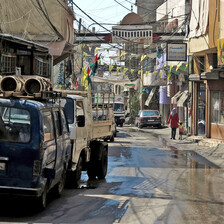Electronic Lebanon 5 May 2008
Since 10 October 2007, residents of the destroyed Nahr al-Bared Palestinian refugee camp in northern Lebanon have been gradually allowed by the Lebanese army to return to the ruins of their homes. However, the core of the camp, the so-called “old camp,” as well as parts of the “new camp,” which doesn’t fall under the mandate of the UN agency for Palestine refugees, UNRWA, remain sealed off and are still under the exclusive control of the Lebanese army.
On 31 March 2008, the Lebanese army made accessible a few dozen houses in Sahabe and Majles Street, close to Nahr al-Bared’s old camp. In Majles Street, 20 buildings on one side of the street were opened, while the other side remained fenced off by barbed wire and army checkpoints. Most of these buildings were home to at least three families as they were several floors tall.
When people entered their homes they found that many of their belongings had disappeared, such as furniture, clothes, and appliances including TVs, refrigerators, computers, gas stoves, and washing machines. Where belongings were not missing, they were either burnt or vandalized. Even the frames of windows and doors, as well as the doors themselves, or bathroom fixtures such as toilets or taps have disappeared.
All 20 buildings bore signs of burning; sometimes, entire rooms or even whole floors were completely burnt. In many cases, there is clear evidence that furniture was used to start a fire within the home. In the al-Majles community center, for example, a fire was set at three different points. In at least in 16 of the buildings, traces of flammable liquids, including petrol and gasoline, could be found on the walls. Thus, many residents doubt that the burnings were caused by shells, grenades or bombs and suspect the Lebanese army of manually setting their homes on fire.
In many homes, there were racist and derogatory graffiti, often directed against residents of Nahr al-Bared and Palestinians refugees in general. In some cases, the army painted over the graffiti before they opened the homes to their residents.
Between the official end date of the fighting in early September 2007 and 30 March 2008, all of Majles Street was under the exclusive control of the Lebanese army. Hence, the military bears full responsibility for whatever occurred in this area and its houses during this period.
Al-Majles street represents what happened in Nahr al-Bared camp as a whole. There is clear evidence of looting, arson and intentional destruction all over the camp. The systematic nature of the destruction points to the implementation of a policy of collective dispossession.
Ray Smith is an activist with the anarchist film collective a-films, which has short films from and about Nahr al-Bared available for download on its website: http://a-films.blogspot.com.
This article is available in other languages on a-films’ website. Download versions of the film in multiple languages are also available on the website.




